
Can getting ‘lost’ in a labyrinth help you find your thoughts? To celebrate the installation of a new projectable labyrinth at the University of Winchester, Dean of Spiritual Life Terry Biddington discusses how this unusual tool can help individuals of all faiths and none meditate or reflect.
Many associate the idea of labyrinths with the concept of getting lost. However, while the terms ‘labyrinth’ and ‘maze’ are often used as synonyms, the word labyrinth is usually used to describe a pattern with one continuous path, with no branching paths or dead ends, making them far from difficult to navigate.
Historically, labyrinths have been found in a wide variety of cultures across the world, including Ancient Greece, Native America, India and Ancient Egypt. They are associated with spirituality and magic and they are often used to symbolise the journey we take through life. Consequently, it is perhaps not surprising to hear that they are often used as a meditation and prayer tool. For example, some Christians use labyrinths as a part of worship and labyrinths have been featured on church walls since 1000 C.E. Some people choose to see labyrinths as a spiritual space, taking their shoes or bowing to the space before entering.
Regardless of our beliefs, however, labyrinths can act as a tool to help us contemplate our thoughts, issues, problems and ideas. Following the path of a labyrinth and seeing where it takes us can help us see issues in a different way. The act of completing the labyrinth occupies the rational ‘thinking’ side of our brain, allowing the creative side to take over, leading to new perspectives and solutions.
These benefits mean that Labyrinths aren’t just for soul-searching and spiritual thought. They can also be used as a tool to inspire creativity, problem-solve and help make decisions.
This is why the University is now pleased to offer a projected Labyrinth in our very own Chapel, in addition to our existing outside labyrinth at West Downs. The labyrinth can projected on to the floor to provide a space for personal reflection. It can also provide a space for students and staff to undertake learning, teaching and research. For example, students on our Creative Writing courses have already made good use of the labyrinth to help them tackle their storytelling quandaries.
So, how does one use a labyrinth to help them reflect, relax and contemplate?
How do you use a Labyrinth?
Traversing a labyrinth allows our mind to wander and gives us time to reflect on the issues or problems we are facing, big or small.
There’s no right or wrong way to use a labyrinth. Ultimately, it is a tool that should be used in the way that helps you most. However, one suggested way of using a labyrinth is to let your mind consider the things that trouble you or the decision you want to make, imagining that the turns in the labyrinth are aiding you in considering the issue from different angles. If it is helpful, you can pause in your journey to tackle thoughts as they come up. Eventually, you will reach the centre. This may not necessarily be the end of your journey with the issue you have been pondering over, but it can be helpful to take the opportunity to metaphorically lay down or let go of these issues here. Alternatively, you may decide to pause in the centre and consider a solution to your problem. Whatever helps you most!
Once you are ready, it is time to move back through the labyrinth. As you do so, leave behind your feelings of conflict and advance with a clear mind. In this way, you can figuratively move forward on to the next phase of your life or thinking.
Labyrinths at the University of Winchester
The University’s indoor projectable labyrinth is situated in the Chapel. The Chaplaincy team at the University are running regular sessions for those who would like to use it as a means to enjoy some quietness and reflection. Details of upcoming sessions can be found on the Intranet. The space can also be booked in the afternoons by staff or students for learning, teaching and research.
If you’d prefer to get lost in the sunshine, we also have a beautiful grass labyrinth situated at our Cosmic Walk at West Downs. The labyrinth is surrounded by flowers, trees and art, making it a fantastic setting for quiet contemplation. It is open access, and can be enjoyed at any time of the year.
There are also finger labyrinths available in the Chapel (on the bookcase). These can be used in the same way as the walking labyrinth but by using a finger to follow the path.
Press Office | +44 (0)1962 827678 | press@winchester.ac.uk | www.twitter.com/_UoWNews
Back to media centre